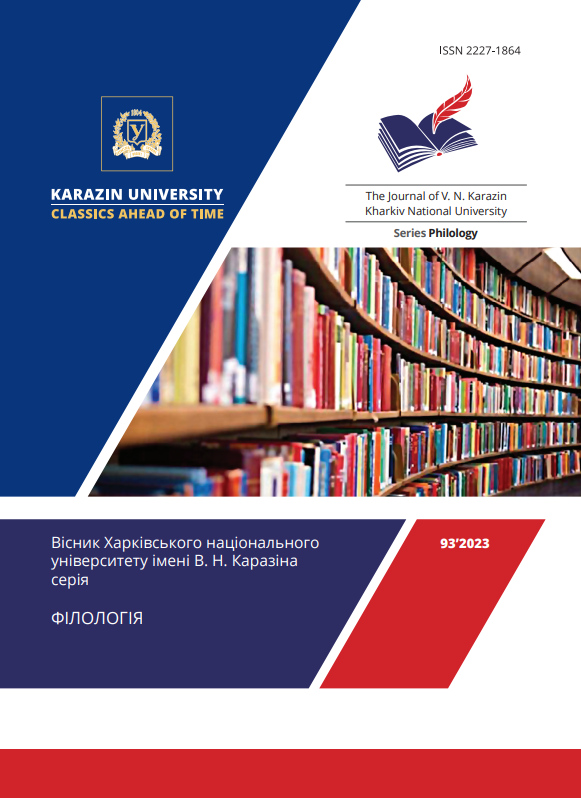Morphological binomials of various types in the Kharkiv Philological School founders’ works, the current state and prospects of the problem study
Abstract
The article is devoted to the study of morphological binomials in the scientific heritage of representatives of the Kharkiv Philological School (KhPhSch), in particular I. Sreznevskyi and O. Potebnia. The state of the development of the issue has been considered. Traditional and modern approaches to the characterization of morphological binomials, ways and methods of their study have been described.
The purpose of the research is to describe the history of the study of morphological binomials in the development of representatives of the KhPhSch, to highlight the current state and promising ways of studying the problem. Morphological binomials are presented in "Materials for the Dictionary of the Old Russian language" by Izmail Sreznevskyi. The history of the formation of the models is covered in the grammatical works by Oleksandr Potebnia. O. Potebnia believes that the morphological pairs "noun - noun" are paratactic attributive compounds, traces of the ancient system of speech. The scientist analyzes not only substantive, but also verbal and adverbial binomials and notes their ability to convey synonymous and antonymous relationships. In modern expressive use, morphological binomials acquire a new meaning and load: they perform the functions of metaphor, metonymy, and under certain conditions can actualize their internal form. Morphological binomials with antonymic relations between elements are able, in a number of cases, to describe binary oppositions, which are universal symbolic complexes.
An integrated approach to the characteristic of morphological binomials is suggested. It involves the combination of semantic and morphosyntactic vectors of classification of the studied units and the use of cognitive and cognitive-discursive methods for their study.
A hypothesis about the modern status of morphological binomials as the units that realize their diachronic potential in fascinating discourses, actualizing the grammatical internal form of the word is put forward. These units acquire expressive and evaluative capabilities due to markedness in comparison with non-hyphenated sequences of morphologically and syntactically homogeneous units. This makes it possible to increase the productivity of binomials.
Downloads
References
Buvalec, E. V. (2012). Double substantive constructions in «Materials for Old Russian language dictionary» by I. I. Sreznevskij and in modern Russian language. V.N. Karazin Kharkiv National University Journal, 1021(66), 131-134.
Bulakhovskyi, L. A. (1956). The issues of Ukrainian language origin. Kyiv: AS USSR.
Holoborodko, K. Iu. (2023). Theoretical principles of lingvoconceptology in the works by L. A. Lysychenko and Ukrainian linguists (general comment). Ukrainian world in scientific paradigms: H.S. Skovoroda Kharkiv national pedagogical university collection of scientific articles, 10, 87-89.
Lavrovskij, P. A. (1852). About the language of northern Russian chronicles. St. Petersburg.
Lysychenko, L. A. (2009). Lexical and semantic dimension of linguistic conception of the world. Kharkiv: «Osnova».
Potebnya, A. A. (1958). Russian grammar notes. Vol. I-II. Moscow: Prosveshhenie.
Potebnya, A. A. (1968). Russian grammar notes. Vol. III. About meanings changes and nouns substitutes. Moscow: Prosveshhenie.
Radchuk, O. V. (2019). The scientific value of research by P.O. Lavrovskyi for modern linguistic cognitive studies. Petro Oleksiiovych Lavrovskyi: scientific and scientific-critical heritage (to the 190th anniversary of his birth): scientific articles collection, 110–122.
Skorobohatova, O. O. (2019). Poetic speech as a source of grammatical studies: Kharkiv Philological School and Linguistics of XX-XXI centuries. Petro Oleksiiovych Lavrovskyi: scientific and scientific-critical heritage (to the 190th anniversary of his birth): scientific articles collection, 33-46.
Sreznevskij, I. I. (1989). Dictionary of the Old Russian language: [In 3 volumes]. Moscow: Kniga.
Toporov, V. N. (2010). World tree: Universal sign complexes. Vol. 1. Moscow: Manuscript monuments of Ancient Russia.
Filon, M. I. (2020). The reader-researcher as a hermeneutic subject. Word culture, 92, 145–154.
Khaliman, O. V. (2019). Evaluation grammar: morphological categories of the Ukrainian language. Kharkiv: Maidan.
Shyrokorad, Ye. Kh. (2000). Petro Oleksiiovych Lavrovskyi. Ukrainian language. Kyiv.




